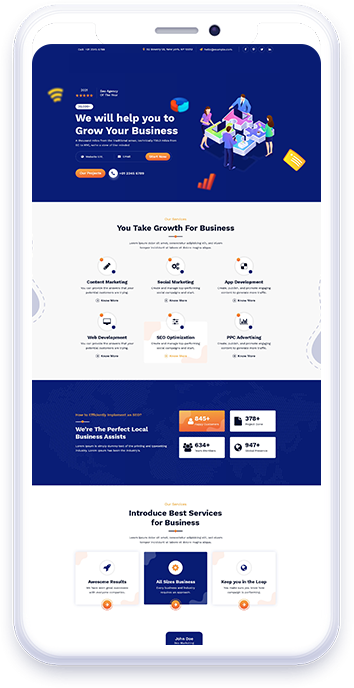Our Features
Our Outstanding Features
Web site development is a broad term which includes web hosting configurations, web development, web site designing, e-commerce web site development, etc.

Seo Optimization
SEO SEARCH GROUP is a SEO Company in New Delhi understands the importance of achieving top position on all the major search engines.
SMO
SMO Stands for Social Media Optimization it is also known as Social Media Marketing,
App Development
We are providing an user-friendly and light-weight app to our clients to do business more effortlessly.
Software Development
We are developing easy-to-use and result-oriented software for businesses to make things easier and better than ever
Digital Marketing
We help businesses to reach potential customers through social media platforms as well as paid campaigns.
Website Designing
We specialize in web designing services which include static, dynamic, landing pages and ecommerce web designing.




Our Team
Our Awesome Team Members
Our team of passionate and innovative designers and developers has proved their presence among the best web designing and development company in Delhi.

CEO

Senior Developer

Senior SEO Executive

Marketing Manager

SEO Manager

SEO Expert

18, Jul 2022
Widgets on the site that will increase the conversion
Widgets on the site take on important functions for users to interact with the content and features of the site. Thanks to widgets, a webmaster can increase the conversion on the site and retain future customers. For example, in a chat, they can chat with support directly on the page, and use the quiz calculator to navigate the cost of the order.
- 0
- By admin

18, Jul 2022
What you need to know about website links
1. How to check social signals
You should not look for many social signals (tweets, likes, etc.) on old resources and in articles published before the advent of Twitter, but they can have comments.
For content that has appeared relatively recently, tweets, pluses, shares, etc. are more characteristic. There are even more of them than comments, as users often prefer to discuss publications on those platforms where they live with their friends. Therefore, the new type of content should have a look and feel that people like and grab their attention. How social media sharing can be used for link building is well covered by Danny Sullivan. This is definitely worth reading.
2. TBPR (Toolbar PageRank) is not real PR (PageRank)
What Google shows in the toolbar is not always up-to-date information. If you’re judging a site by TBPR, you’re doing the wrong thing.
3. What is link equity
Link equity is basically the amount of trust that is transferred from one page to another. Nofollow is designed to prevent the transfer of trust. This is a much more complex concept than the example below, but it captures the essence of how this whole system works (note that this is not an exact/real formula, just a demo):
Let’s say page A has a link equity of 10. This page has five links to other sites. Thus, each page that A links to will receive 2 link juice points.
Let’s say Page B also has 10 link equity. It leads 10 links to other sites, but 5 of them are under nofollow. As a result, each of the five non-followed links passes the same 2 link weight points. Pages linked to with nofollow do not receive any link juice.
4. What is PageRank for?
To use the idea of link equity that the author shared above: Page Rank is an attempt to create a mechanism to pass on higher link juice from some pages, and prevent them from passing on from others whose links will not matter to Google.
5. How to optimize internal links
Above, we talked mainly about optimizing links leading to your site from third-party resources, but did not touch on internal ones.
The main task of internal links is to help the user in finding the right information on the site. Therefore, there is nothing wrong with the fact that the anchor of the link that performs this function contains the relevant keywords. An excellent article on site structure.
6. How to identify nofollow links
Yes, there are plugins that can highlight them, but that’s not enough. Take a look at the source code of the page. If you find rel=nofollow in your link, then it does not pass weight.
7. How to choose keywords
There are tons of free and paid tools that do the job. Here are some of the ones the author uses:
• SEOBook
To work in Runet, we can recommend Key Collector and Amazing Niche Finder .
8. How to write well and not just “good enough”
Julia is a true spelling and punctuation fanatic. She believes that poorly written content (be it a blog post, email, article, or anything else) creates a bad impression about the person who created it. He seems to be constantly in a hurry and cannot pay due attention to any of the tasks being solved.
Some people are overwhelmed with fantastic ideas and great thoughts, but do not know how to correctly express them in writing (on the keyboard). The spell check feature is not in vain. Other people write just to get content out of their head. Watching them work is a real pleasure. But if you don’t consider yourself a gifted writer, then practice. Read great writers and you will become a better person. Do not forget about the importance of literate texts.
9. How to find people of influence
By people of influence, the author understands those whom we can influence and those who influence us. Let’s say you’ve been doing some subject for a very, very long time, but still, there are people who have even more experience and do it better than you. It is on them that one should be equal and take all the best from them.
To find such a person, Julia Joyce recommends using Crowdbooster and its Influential Followers panel. This lists your Twitter followers and their number of followers. If you want to find someone who has a huge impact on the audience, then you can use this tool.
Just remember that influence is not always directly correlated with the number of followers. Don’t ignore people trying to connect with you just because they don’t have thousands of followers. The influence of many people extends much further than Twitter, and therefore its metrics can be very wrong here. Julia can name some very influential people, from her point of view, who have less than 1000 followers on Twitter. She gets much more benefit from communicating with them than from contacts with many other influential people. If the need arises, she turns to them, as she is sure that she will receive an answer.
10. What to say about the link that gives you traffic
Everything is extremely simple, but it is necessary to mention this point, as recently the author met a person who is very concerned about the problem of removing potentially dangerous links. She asked him if these links were driving traffic, to which he replied: “How should I know?”. If you use Google Analytics, it’s easy to find out if these links are bringing in traffic. You need to go to Traffic sources – Sources – All traffic.
If you are about to delete a link, but it brings you significant traffic, see how that traffic converts. If there is no conversion, and you still want to remove this link, then you can safely do what you intended, and then see what happens. If the link brings convertible traffic, then the author recommends leaving it in place.
11. How to find broken links leading to website pages
If you are the lucky owner of “fat” links, but they point to a non-existent page that does not lead to a 301 redirect, then it is very likely that you are wasting all their weight. Also, this is an example of a bad user experience. Make sure that your site does not give a 404 error anywhere. If this could not be avoided, then you need to use one of those tools that allows you to find the sources of broken links.
You can use the W3C Link Checker to analyze broken links, redirects, and other related things . This tool is free.
If you see a good link leading to a page that doesn’t exist, take care of a 301 redirect or contact the webmaster whose site the link is on and ask them to change the URL. The last option is the most preferred, as link juice will not be lost when passing through a 301 redirect.
However, if there are 500 links to that page, then a 301 redirect would be the best solution in terms of wasting your own time. Otherwise, you will have to send out 500 emails, and then make sure that the webmasters understand you correctly and do everything as you asked.
12. How to find mentions of your site that haven’t turned into links yet
One of the easiest ways to accomplish this task is to use Google Alerts . This service will report all new mentions of your name, site name or its URL on the network. If something new appears on the Internet that concerns you, but without a link, ask the webmaster to put it, of course, if you want.
If people want to mention you, they can link to your social media account. You can contact them, thank them for drawing attention to your person, and ask, if possible, to put a link directly to your site. Here you should act very carefully, as some people may consider you too arrogant, because they have already done a favor by paying attention to you.
13. What is a bad link environment
Often you have to deal with clients who do not want links to their sites placed next to links leading to resources of certain categories. We are talking about the effect of bad link environment, the essence of which is that we can have a great link to our site, but it is surrounded by others that can be considered as spam. Usually this is a set of all kinds of links that are not related to each other in any way, and installed for money. Such links can lead to the fact that the quality of the site in the eyes of Google will drop.
The link environment can also become bad because it was a grid that was exposed by the search engine, links from it are devalued, or content is removed from the index. Approach choosing a site for placing a link in the same way as choosing a trading place for opening a children’s clothing store. You don’t want a strip bar next to his door. Ideally, there should be a McDonalds and a children’s book store nearby.
Google recommends that you don’t “link to web spammers” and stay away from “bad environments” as your site’s rankings may suffer due to these links. As you can see, this rule works both ways. You should avoid links from bad environments and you should not link to such sites.
14. What are link explosions and why you should worry about them
A link explosion indicates a link network activated in a very short amount of time. If this is not the work of your hands, then it may be a signal of an attack on your resource using SEO methods with a negative effect. On the other hand, it can be quite normal for many links to appear at the same time (think press releases, new TV ad campaigns, etc.). But if this happened, then it is absolutely necessary to analyze the current situation.
This phenomenon looks a little strange, doesn’t it? If someone turns to Julia for advice and says, “I think some of the old links are doing harm to the site,” she opens Majestic and analyzes the link history. The surge in 2008 suggests that not everything is clean here (maybe a grid was used?).

But it is possible that we are witnessing a natural effect. Be that as it may, after such an analysis, she can ask the right questions to this person.
15. Which sites or links should be suspicious
If the site’s content doesn’t match its domain name at all (say, the site housing-mortgage.rf contains information about caring for pets), then something is clearly going on here.
If you notice that for no reason at all, new links began to appear on your resource in large numbers, then you definitely need to look at which sites they lead from. Given what’s been going on lately with Google, links, negative SEO and link warnings, we can’t consider ourselves completely safe.
16. You need to carefully read the content contained on the site
In other words, don’t rely on some metric to characterize it. Wonderful, what good indicators! Sometimes we are overwhelmed with a huge amount of work, and therefore we are looking for ways to make it easier, to find ways to quickly analyze the site, while forgetting to slow down and read what is actually written on its pages.
Sometimes the author came across links that at first glance seemed simply fantastic. The resource looked completely relevant to the niche, the links seemed worthy, there were good social signals, their dynamics seemed to be positive, but after reading the articles, an unpleasant feeling was created that they were written by a robot. Links from such sites may help in the short term, but in the future they will not turn into a source of additional traffic.
17. What is Markov content
Markov content is text randomly generated from normal materials. At first it may seem that it was written by a person in a language that is not native to him, but if we try to delve into the essence of what was written, we will understand that it is not.
Stay away from sites with such content, and do not leave links to them that lead to your resources.
18. How to check content for duplicates
Copyscape will tell you absolutely free of charge if a copy of your content has appeared somewhere on the web. This tool also has a premium version, which will help you find out how original (in the sense of the text component) is the material that you just want to place on the site. For Runet, programs such as Advego Plagiatus and Etxt Antiplagiat are relevant .
Since sites created from copied content can worsen the ranking of source pages, you need to know how to make sure that this circumstance is not the cause of poor positions of the resource for which you are building links.
19. How to figure out if the source of the problem is links or something else
Because of the recent panic over unnatural link warnings, they’ve been hit with more curses than we’ve ever heard before. Links can be a source of trouble, but one must learn to recognize if the trouble is due to links or something else.
20. How to use advanced search arguments
If you’re doing manual checking, then advanced search arguments can save you time by getting rid of a huge amount of unnecessary results. Here is a good list of arguments to search on Google.
21. What does rel=author mean and how can it be used
When Julia first read about it, everything seemed very simple, but in practice there were some difficulties. She considers the publication on Verve Search and the article by Rick DeJarnette to be one of the best tutorials on this topic . If you write a lot, you should definitely set up this feature.
It’s kind of like a personal version of the brand effect, with which you can create a trusted name and improve your online visibility. If something you wrote will be displayed in the search results, then through the link More By Author X, visitors will be able to see other materials under which you “subscribed”.

22. What is wrong with cross-links and links from footers
Crosslinks are usually placed in footers, but they can end up in other places as well. Through we call those links that lead from all pages of the site. A few years ago they were used to get a lot of links at once. Sometimes it works even today. Links from blog rolls, if it’s a topical blog, still matter to this day. According to the author, this approach is quite legitimate.
But if you scroll all the way to the bottom of the page and find a long paragraph full of cross-links, that’s not the best situation these days. Such patterns are easily recognized and devalued by search engines. This is exactly the case that the author spoke about above: links that do not make sense. In short, if the link is not placed inside the actual content on the page, in most cases, it cannot be good.
23. How to find out the number of end-to-end links leading to the site
Most people Julia Joyce encounters can’t check if a link to their site is through. She herself does this work by hand. If you run any utility to check the links to a site, you can see many referring pages located on the same domain. This is what we are looking for.
Some people continue to use cross-links, but many link builders are no longer actively looking for opportunities to post them. A large number of experts believe that cross-links have become worthless, and some even think that they harm the site. The author thinks that cross-links might be justified, but I’m not sure that search algorithms are smart enough to establish the degree of their legitimacy.
24. Why you need links to internal pages
Many are engaged in link building not only for the main page, but also for internal ones. After all, if the links lead only to the main page, then it seems that the site does not have any worthy information, except for the one posted here. This does not form a very good signal.
25. What is rel=canonical
You can read about it in detail here , but in short, it indicates the preferred version of the material if similar content is found elsewhere.
26. How to view the page code
You will be surprised to learn that so many people do not know how to view the code of a page. In Chrome, right-click on the page and select View Page Source, and do the same in Firefox. Julia predominantly uses these two browsers. If in the program you are using this operation is done somehow differently, open your eyes wider and look for how.
In order to make sure that the link is not under nofollow, you can simply look at the page code without resorting to the use of special plugins. This will also come in handy in order to make sure that search robots on this page are not blocked, as well as to determine the reasons why the link does not work as you expected it to. It’s relatively common to see links that don’t have a proper closing tag.
27. When and how to send a request to return the site to the search engine
If the site was penalized, but you fixed all the points that caused them, then it’s time to send a request for review. If you haven’t cleaned up everything that the site has suffered for, then don’t waste your time preparing and submitting a request, hoping that Google will be in a better mood today and turn its anger into mercy.
Of course, no one will stop you from sending a review request, but if the reasons for the downgrading of the site are present, as before, then this is not a good idea. If you notice unpleasant trends after updating the algorithm, but these are not penalties, then you can try to make some changes on the site and wait for the next update. If you made the right conclusions, then everything will return to its place.

18, Jul 2022
Blog Links for SEO
The third series of mailing …
How blog links work What is a “blog”?
The word “blog” comes from the abbreviation of the English weblog, that is, “network diary”. The first blogs were ordinary sites, and they took a special position only after the appearance of large sites like LiveJournal and integration with the RSS format, ideal for “portioned” delivery of content to search engines.
How are links from blogs different from regular ones?
From the point of view of the search engine, a blog is a site whose main page is made up of the content of the latest pages-records – full or announcements. Information is added to the blog by creating separate new post pages (posts). Any modern blog can present data in the RSS (Really Simple Syndication) XML format. This means that an “interested” service, for example, a search engine, can receive ONLY NEW data on the first request in a format that has already been processed and is optimal for indexing. It is this ability to request only updates via RSS that led to the highlighting of the main feature of blogs in terms of SEO – very fast indexing by search engines.
Everything is logical: instead of reindexing the entire site every time in search of changes (which is exactly what a search engine has to do with ordinary resources), the search engine receives a very small “portion” of updated data and adds them to the blog index. Thanks to this, blogs that are updated quite often are checked by Yandex every 5 minutes! So far, this figure is unattainable for regular sites: updating the index (update) of such resources occurs much less frequently.
Obviously, this is a huge plus in terms of SEO – if you need to get indexed links to any page as soon as possible, then there is no alternative to blogs. This is usually used to speed up the recipient page (the page to which links from blogs are bought) gets into the search engine index.
Types of Blogs
Blogs fall into two categories: standalone and hosted blogs.
Standalone blogs are separate sites on separate domains that have one of the popular blogging “engines” installed, that is, a CMS (content management system). The first place among CMS for “stand-alone” blogs is confidently held by WordPress, although some use Movable Type and regular CMS for sites – almost every one has the functionality to create a blog lately.
Advantages:
- independence from the politics of blog sites;
- the ability to more fully apply SEO methods to promote the blog and increase its parameters as a donor site;
- huge opportunities for customization and customization.
Flaws:
- a flawed mechanism of social interaction (only through commenting, as well as the ability to notify another standalone blog about the presence of related material: for example, a post with an answer to an article – Trackback);
- the need to understand the intricacies of working with hosting, installing and configuring the distribution;
- require payment for hosting and domain.
Platforms for blogs (blog hosting, blog services) allow you to easily and without any special knowledge to maintain any number of blogs. Many sites provide blogs with third-level domains – for example, blogblogblog.livejournal.com , which allows you to work with them (that is, optimize, promote, increase parameters important for SEO) in almost the same way as with regular sites.
Now the most important thing: in terms of SEO, the difference between links from standalone blogs and blog hosting blogs is small. If the resource is not a splog (splog = spam blog), links from it contribute to fast indexing and pass a certain “weight”. The advantage of standalone blogs is a second-level domain, the advantage of blog services is initially debugged and does not require any gestures from the blog owner (for example, configure pinging blogs.yandex.ru , etc. using the ” Ping Monitoring ” service) interaction with search engines ).
Heterogeneity of the link mass is a plus for promotion
Search engine ranking formulas give preference to sites with incoming link mass, which has a high degree of “naturalness”. It is logical that if a site has links from pages of other sites, from articles, from various blogs, and so on, then it is either really popular or well promoted. The heterogeneity, (heterogeneity) of the link mass helps the site being promoted to quickly increase its positions and more stable to stay in the won places.
SEO or Audience?
It should be clearly understood that attempts to bring a real target audience to the site by buying links on blogs is a thankless task. Yes, many really popular bloggers are not shy about publishing ads, but any work with the audience should be thoughtful and based on the principles of marketing. Trying to attract people from blogs directly is in the realm of your own experiments and is not SEO related. A link or an entire post bought from a blogger with a real, live audience will have both a PR and SEO effect, but their cost is orders of magnitude higher than a link with similar parameters and efficiency, which can be purchased through a special blogging exchange.
Services for buying links from blogs
Obviously, you should not “manually” buy links from blogs by writing off or otherwise contacting their owners. Usually, for a noticeable effect, you need to buy several tens, or even hundreds or thousands of links. Fortunately, there are special blog link exchanges: blog owners who want to earn income add their sites there, and people interested in buying can easily select blogs with the right parameters and buy the right number of links.
Among the blog exchanges, BuyPost can be singled out – a system that was originally “sharpened” for SEO. BuyPost provides very interesting opportunities both for blog owners (full automation, placement of links in old posts, very fast redemption of all places), and for buyers of links (manual blog moderation, high-quality and cheap links). You can work with this exchange both directly and through promopult – users of the system have the opportunity to buy links to promote their projects and on BuyPost (if necessary, purchases on any of the exchanges can be disabled, although analysts’ experiments show that this should not be done – with links from blogs, sites really move better). As an example, we can cite the data of an experiment set up by promopult analysts during the launch of the current version of the Yandex algorithm – Snezhinsk 1.1. The graph below shows that sites that were promoted exclusively by links from blogs improved their positions after the algorithm update. Obviously, the role of blogs has grown, and their use in the overall promotion strategy is more than appropriate.
Among the leaders in the Internet promotion industry, Blogun should also be mentioned, but this system positions itself more as a PR tool: the service’s policy is aimed at automating audience acquisition, but not at selling relatively cheap links for SEO.
Conclusions
So, links from blogs are useful for search engine promotion, but it is necessary to clearly understand the difference between “SEO-links from blogs” and “links that theoretically could lead to the target audience.” In the context of search promotion, it is obviously worth buying inexpensive SEO links, carefully monitoring their quality (or entrusting this to the moderators of the BuyPost specialized blog exchange).






